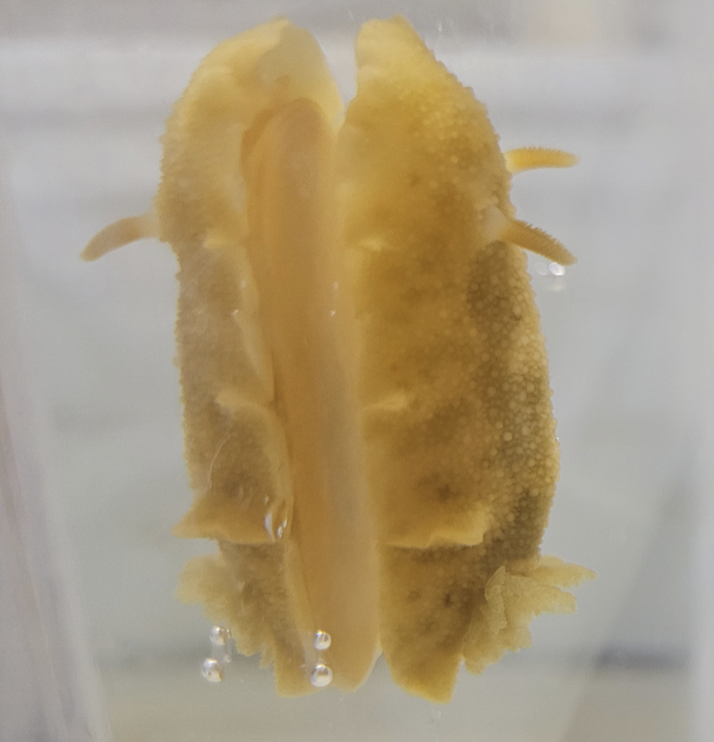
Norwalk, CT – During a recent Lobster Trap Recovery and Assessment Partnership (L-TRAP) trip to retrieve traps that were lost over decades of fishing, The Maritime Aquarium at Norwalk and colleagues from Williams College and Project Oceanology discovered a European nudibranch, Doris pseudoargus, in Long Island Sound.
“Beyond protecting benthic habitats, this discovery is one of the reasons why our L-TRAP project is so exciting,” said The Maritime Aquarium Director of Conservation and Policy Dr. Sarah Crosby. “There is so much that we don’t know about the bottom of the ocean, including which animals are living right here in our backyard. This project is allowing us to study the biodiversity of the Long Island Sound ecosystem like never before.”
The specimen, measuring 1.5 inches in length, was found in the Black Ledge area of the Sound off the coast of Groton, Connecticut – the most southern discovery of the species in North America. The Aquarium is currently holding it for study to assess its potential impact on the Sound.
Doris pseudoargus is a yellow nudibranch that feeds entirely on sponges. The species is most commonly found in European waters, but has been observed near Cape Ann, Massachusetts since 2017. Its possible expansion into the Sound has the potential to increase stress on the ecological role of local sponges.
The nudibranch isn’t the only novel species that has been spotted by the L-TRAP team. Over the past year, they have also observed two new species of bryozoans in the Sound, Amphiblestrum auritum and Fenestrulina delicia.
The Maritime Aquarium Conservation Research Assistant Rebha Raviraj said: “When I first noticed the nudibranch on the lobster trap, it looked entirely different from any other animal I had seen being pulled up. With a striking yellow body and interesting feeding behavior observed on the trap, this creature immediately seemed unique.”
Williams College Professor Emeritus of Marine Studies Dr. James T. Carlton said: “The appearance of this large predatory European seaslug in southern New England may have important repercussions for native sponge populations, but studies will be required to document impacts. Native sponge populations are important consumers of bacteria, and can host large populations of small crustaceans and worms that are important in fish diets. Retrieving abandoned lobster traps in Long Island Sound has revealed important new insights into the Sound’s marine life.”
Project Oceanology Director of Curriculum and Instruction Callie Scheetz said: “As an organization that has been working with benthic organisms in Long Island Sound for 51 years, we quickly recognized this find as something unusual. The significance of this data collection extends beyond observation; it is a crucial piece of the puzzle in monitoring and understanding the prevalence of invasive species in our local ecosystem. Recognizing the power of citizen science as a driving force behind discoveries like this, we encourage community involvement by leveraging applications like iNaturalist. Our team is excited for future trips with industry partners and local experts, like Captain Walter Roderick and Dr. Jim Carlton, to continue tracking data and learning about the changes of Long Island Sound.”
The L-TRAP project is a collaborative effort between the Aquarium, Project Oceanology, Save the Sound, Cornell Cooperative Extension of Suffolk County, Remote Ecologist and local fishers to collect abandoned traps that continue to attract and trap animals, disrupt habitats, and interfere with the work of the remaining members of the fishery.
The L-TRAP team’s discovery has also sparked conversation between conservationists about another novel nudibranch species in the Sound, Doriopsilla pharpa. Harbor Watch first noticed it in Norwalk Harbor in May. It is most commonly found in the southeast region of the United States, but is moving north with warming water temperatures.
Members of the public who spot any of these novel species can make an observations on the iNaturalist app and alert the L-TRAP team by emailing lobsters@maritimeaquarium.org.
THE MARITIME AQUARIUM AT NORWALK inspires people of all ages to appreciate and protect the Long Island Sound ecosystem and the global environment through living exhibits, marine science and environmental education. The aquarium is home to over 7,000 animals of hundreds of species including seals, sharks, rays, jellies, turtles and meerkats. Additionally, it offers sensory-enhanced 4D movies, in-person and virtual education programs for schools and families, and public cruises aboard its hybrid-electric research vessel. The Maritime Aquarium is an accredited member of the Association of Zoos & Aquariums, and receives support from the State of Connecticut DECD’s Offices of Culture and Tourism. For more information, visit www.maritimeaquarium.org.